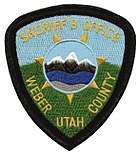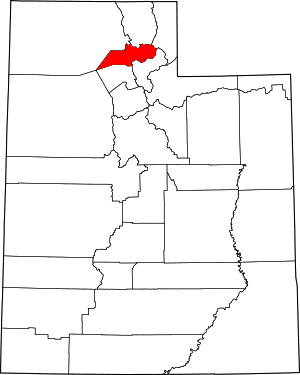Weber County Sheriff's Office
The Weber County Sheriff's Office is a law enforcement agency in Weber County, Utah.
| Weber County Sheriff's Office | |
|---|---|
 | |
| Abbreviation | WCSO |
| Agency overview | |
| Formed | 1850 |
| Jurisdictional structure | |
| Operations jurisdiction | Weber County, Utah, USA |
 | |
| Map of Weber County Sheriff's Office's jurisdiction. | |
| Size | 661 square miles (1,710 km2) |
| Population | 196,533 |
| Legal jurisdiction | Weber County, Utah |
| Operational structure | |
| Headquarters | Ogden, Utah |
| Agency executive |
|
| Units | List
|
| Website | |
| Weber County Sheriff’s Office | |
History
The county's territorial sheriff had responsibility for all Weber County boundaries as defined by the Utah Territorial Legislature in October 1850.
The county was immense. The 42nd parallel, the southern boundary of the Oregon Territory, current southern boundary of Oregon and Idaho, became the northern boundary of Weber County and was also the northern boundary of Utah Territory. The western boundary of Utah Territory was the Sierra Nevada in California, which also became the western boundary of Weber County. The county also acquired new territory to the east with the county boundary being set where the Weber River "enters a canyon about four miles below the ford on Emigration road." The southern boundary of the county ran through a point at "the junction of the county road and the head water of Rocky Creek, being about two miles south of the mouth of Weber River Canyon. This boundary line extended west to California.
In 1855, due to additional growth, the boundaries were changed. The area in Weber County that now is Davis County was defined as Davis County. In 1862, the area of Box Elder County was formed, thereby reducing Weber County's size further.
In 1866 Weber County lost a piece of land that became Morgan County. In 1880, Weber County was given a wedge-shaped portion of the Great Salt Lake. This also brought Fremont Island under Weber County jurisdiction. In 1898, the state legislature codified the boundaries of the counties.
On August 4, 1851, Benjamin F. Cummings was elected Sheriff. During this time, he was also a Captain in the county militia. By 1857 he had been raised to the rank of Major. The Weber County Sheriff's Office had its beginnings in 1852 when probate judge Isaac Clark of the Weber County Court appointed R. W. Cummings to the office of County Sheriff. The city marshal and the sheriff worked closely with the city and county courts to enforce the laws.
Many settlers during this period of time lived on a city lot in Ogden and had additional acreage to farm in outlying areas surrounding Ogden City. In 1854, the population of Ogden was approximately 150 families, Uintah City approximately 35 families, North Ogden had 47 families, Bingham's Fort (northwest end of Ogden) had 732 residents. The county had three schools and two stores. The U. S. Census of 1850 lists the population of Weber County at 1,141 people.
Henry Beckstead and his family were one of the first settlers in the Uintah area of Weber County. He was the second Sheriff for Weber County from 1856-1859.
Lester Herrick, a local businessman in the area, was the Sheriff of Weber County in 1860. He was later elected mayor of Ogden City for seven two-year terms. He held the office in 1871, 1873, 1875, 1879, and 1881. There were two parties: the Liberal party and the Peoples Party. Mayor Herrick ran on the Peoples Party ticket. By 1860, the population of Weber County was 1,807.
During the 1860s, Weber County continued to grow with additional commerce and industry. In 1862, President Abraham Lincoln signed the Pacific Railroad Act into law.
By 1870, the population of Weber County had increased to 7,358. The increase was tied to the coming of the railroad.
William Brown and Thomas J. Stevens were elected Sheriffs of Weber County during the coming of the railroad. The Union Pacific Railroad track was completed to Ogden on March 8, 1869. The expansion of rail lines through Echo Canyon provided work for citizens living in Weber County. Ogden City Mayor Lorin Farr and his partners contracted with Central Pacific Railroad for work maintaining Central Pacific lines. With the coming of the railroad, the population increased, as travel from coast to coast now only took seven days. As the population increased, crime throughout northern Utah also increased.
By 1880, the county had 12,344 residents. This increased to 22,273 by 1890.
Gilbert R. Belnap was elected sheriff of Weber County in 1884 and served 14 years in that position. As sheriff, he was involved in arresting a variety of criminals, including train robbers, gamblers, and other law-breakers. Belnap was paid $80 a month and had to furnish and feed his own horse and equipment. One of his most famous arrests was that of Joseph Nay and E. K. Fisher, who had robbed a Denver and Rio Grande train in September 1889 and were captured in an Ogden pool hall. When they were captured, Belnap noted that they had enough "dynamite cartridges" on them to blow up the building.
Weber County sheriffs in Utah's history
- 1852 -1855 Benjamin F. Cummings
- 1856 -1859 Henry Beckstead
- 1860 Lester J. Herrick
- 1861 L. Alvin West
- 1862-1870 Gilbert Belnap
- 1870-1883 William Brown
- 1883-1884 Thomas J. Stevens
- 1884-1894 Gilbert R. Belnap
- 1895-1896 Heber Wright
- 1899-1902 Charles E. Layne
- 1903-1906 Joseph W. Bailey
- 1908-1910 Barlow Wilson
- 1911-1913 Edward E. Harrison
- 1913-1916 Thomas A. Devine
- 1917-1920 Herpert C. Peterson
- 1921-1930 Richard D. Pincock
- 1931-1934 Amasa M. Hammon
- 1935-1937 Oscar Lowder
- 1937-1946 John R. Watson
- 1947-1954 Mac Wade
- 1955-1966 LeRoy Hadley
- 1967-1970 Wilson A. Allen
- 1971-1978 Edward Ryan
- 1978-1990 George Fisher
- 1991-1997 Craig Deardon
- 1997-2011 Brad Slater
- 2011–2019 Terry L. Thompson
- 2019-Present Ryan Arbon
Fallen officers
Since the establishment of the Weber County Sheriff's Office, one officer has died in the line of duty.[1]
| Officer | Date of Death | Details |
|---|---|---|
| Chief Deputy Seymore Legrande Clark | Friday, November 27, 1908 | Gunfire |